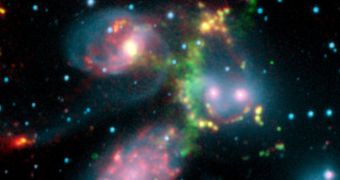A team of astronomers announce the discovery of a massive sonic boom, a huge intergalactic shock wave, in the group of galaxies known as Stephan's Quintet. At this point, this agglomeration of 5 galaxies is on the verge of producing one of the most impressive cosmic cataclysms.
The five structures are colliding in pairs among themselves, and also with all the others in the system. In the end, all of them will merge into a gigantic elliptical galaxy, which will likely dwarf the Milky Way in size and spread.
Using the NASA Spitzer Space Telescope, investigators recently conducted a series of observations of this system, in infrared wavelengths. Their research revealed the existence of an enormous shock wave between these galaxies. Such a phenomenon is known among astronomers as a sonic boom.
The international collaboration of scientists that made the discovery was coordinated by experts from the Max Planck Institute for Nuclear Physics (MPIK), in Heidelberg, Germany. The new view of the Quintet provides experts with new data on what happened in the early Universe.
Billions of years ago, collisions and mergers between galaxies were commonplace in the Universe. The entire Cosmos was a lot smaller than it is today, and was also expanding at a slower rate. This allowed multiple galaxies, including our own, to collide with others.
Stephan's Quintet is located a mere 300 million light-years away, which is close in astronomical terms. Studies of the system have revealed an odd distribution of light among the five components, but thus far astronomers have remained largely oblivious to the existence of the shock wave.
The structure is one of the largest ever discovered in space. Recent measurements conducted in both radio and X-ray wavelengths discovered massive volumes of hydrogen and helium gas between the galaxies, weighing about 100,000 million solar masses, Daily Galaxy reports.
Working together with colleagues from the California Institute of Technology (Caltech), in Pasadena, the MPIK team discovered that the shock wave is produced by the galaxy NGC7318b, which is moving towards the other four at tremendous speeds.
As it moves along on its path, it displaces massive volumes of the gas clouds, which in turn contributes to creating the remarkably-large shock wave. The strong radiation that molecular hydrogen gives off is what allowed Spitzer to identify the structure.
“The strength of the emission and the fact that it shows the gas to be highly disturbed was a huge surprise to us,” team leader Dr. Phil Appleton explains.
“We expected to see the spectral signature of dust grains – but instead we saw an almost pure laboratory-like spectrum of hydrogen molecules and almost nothing else. It was quite unlike anything we had seen before in a galaxy system,” adds the Caltech expert.

 14 DAY TRIAL //
14 DAY TRIAL //